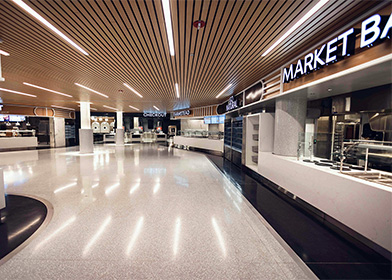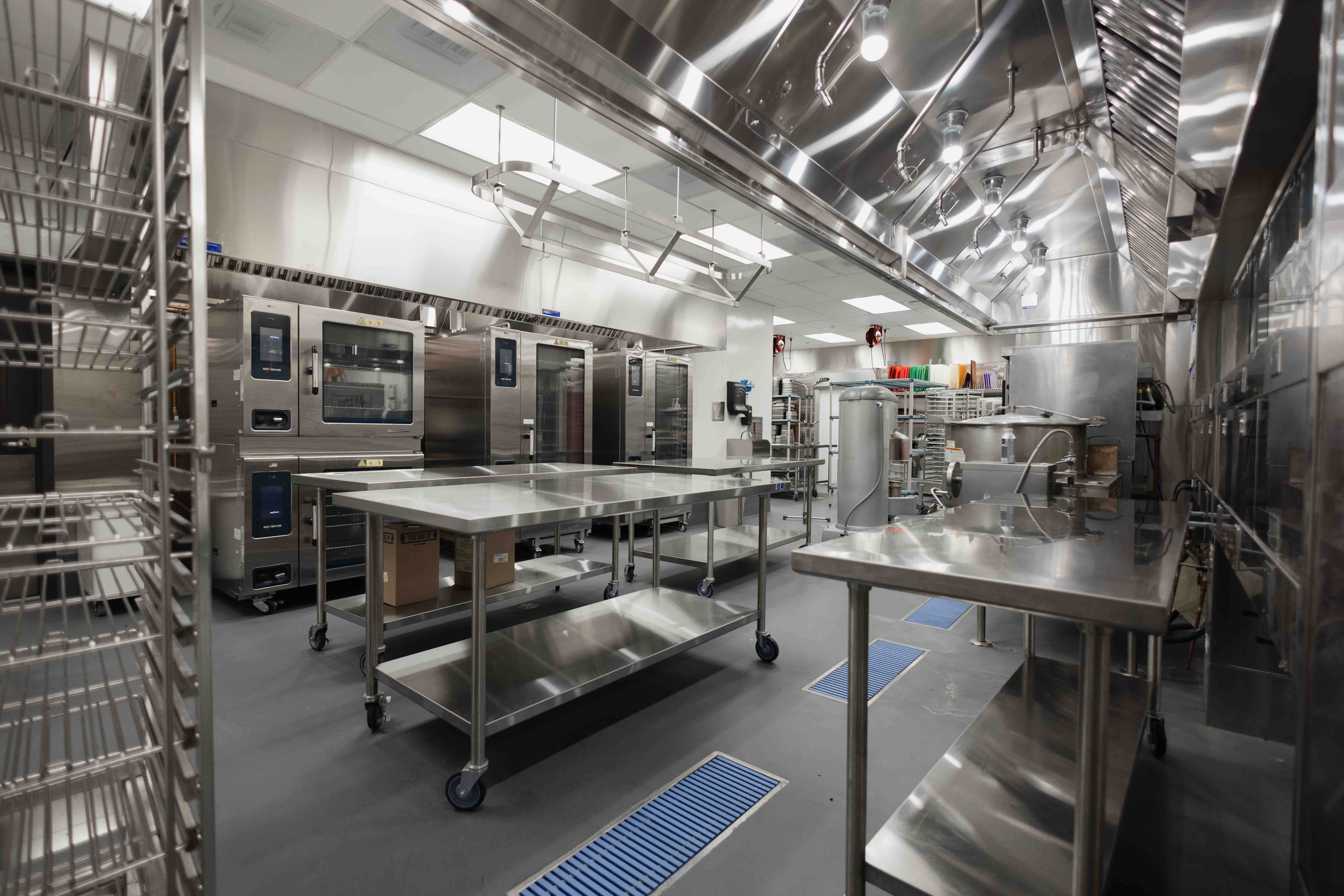
A FRESH START FOR FOOD AT CHICAGO’S MUSEUM OF SCIENCE AND INDUSTRY
Location:
Chicago, IL
Scope:
Bar Design, Equipment Supply & Installation, Furniture Supply
Every day, thousands of people travel through the Museum of Science and Industry, one of the largest and most interactive science museums in the Western Hemisphere. Making your way through exhibits where you might find yourself learning how the body moves while running on a hamster wheel or experiencing what it’s like to be inside a tornado first hand can really work up an appetite. The food court itself is an integral part of the museum experience, and was in desperate need of an update.

In late 2022 Chicago’s Museum of Science and Industry unveiled a new dining experience for its guests – a total transformation of the foodservice offerings at the museum and one that was years in the making. “Whether guests are at exhibits or the food court, it’s all a part of the museum experience, and we wanted to ensure we set ourselves apart from other cultural institutions in town with a unique offering,” says Brad Scheiver, AVP of business services and guest engagement, MSI. The kitchen and dining area had not seen an upgrade in almost 15 years, paving the way for plenty of changes to bring the offerings up to date and in-line with the museum’s current focus on sustainability and good health.
“We brought in Boelter from the very beginning of this project, which dates back to 2017,” Scheiver says.” They not only sat and listened to our ideas, but their knowledge of the foodservice space and relationships with equipment and furniture vendors really allowed us to expand our horizons and achieve what we wanted to accomplish.”
In order to meet the overarching goal of updating the museum’s entire foodservice operations, Boelter focused on a few core priorities:
- Improving efficiencies, in both new, energy efficient equipment and a better flow for workplace productivity.
- Focusing on fresh foods made on-site.
A Focus on Fresh
More than 1.5 million people visit MSI annually, and at least one quarter of those visitors are school-aged children. For a food court that’s feeding the future, the goal of the renovation was to provide healthy options, made on-site with fresh ingredients. For Boelter’s team, that meant redesigning the cafeteria-style offering into a free-flowing dining area.
“Our goal with the project design was to open up the space and let customers flow through, giving them the feeling that food is being prepared just for them,” says Eric Chaplick, director of operations and design. “On our end it meant being creative about where we placed the stations, to take into consideration the existing hoods and ductwork while at the same time creating a new space that met the goals of the project to have fresh food prepared in front of guests.”
Working around existing ductwork was one of the biggest challenges, but it was a necessity not only to keep the project within budget but also to reduce construction issues that come from working in a building originally constructed in 1893. Chaplick rose to the challenge, finding a way to create new stations with existing hoods while still opening up the space for guests to come through and see food being prepared right in front of them.
The new food court includes four stations where many of the tasks that had been done in the kitchen are now done right in front of guests, from food prep to actual cooking. That meant designing each station with plenty of space for staff to work, as well as storage to keep all the ingredients at hand.
The Crust Station brought the former pizza station out and forward to make it more of a showplace. In addition to making all the dough for pasta, pizzas and calzones, the area is also equipped to make the majority of the bread needed in the operation. Other stations include a Market Station with a high capacity fryer and a smoker, allowing for menu items ranging from ramen to barbecue or brisket, as well as a grill and a deli.
Flexibility was a key aspect of the operation’s overall design. Each station is set up with equipment that allows versatility in menu options, from a grill that can be a flat top to storage wells able to switch from hot to cold. One station also has an induction counter top that is cool to the touch but heats up with hot pads at any place.
The goal of flexibility wasn’t solely focused on food production. It also meant having the ability to adjust throughout the day or seasonally to the ebb and flow of traffic. Bringing out much of the food production from the kitchen to the stations allows some stations to be closed to guests during off-peak times while still bustling with activity as staff prepares product to support the entire dining operation.

The Expert Advantage
It wasn’t just the food offerings that got a facelift, the furniture and décor were updated as well with a crisp, white theme with bright colors as accents and new warm wood grains.
Improving the aesthetics also meant picking out just the right chair. “We had a lot of demands when it came to seating,” Scheiver admits. “We needed something stackable that would slide easily. We also wanted durability to last through multiple field trips full of kids, and that included chairs that could be cleaned easily. The biggest thing was probably finding a chair without perforation or holes that little fingers and legs might slip through.” Thanks to Boelter’s relationships in the industry, the team was able to bring in a variety of samples to choose from. “We could see, touch and feel the product before making our final decision, and really benefitted from the expert knowledge of Boelter’s team,” Scheiver says.

Improving Efficiencies
The back of the house got a facelift during this renovation as well, upfitting the kitchen with a host of new equipment. From new ovens and kettles to refrigerated storage and walk-in coolers, everything was redone with an eye on energy efficiency and flexibility. The kitchen serves not only as support for the operations going on at the stations, but also as the catering facility for museum special events that can host anywhere from 1,000 for a plated dinner to 12,000 for a pass-through event.
Boelter’s design team used a combination of creative design work and equipment knowledge to meet the project’s goals. “Everything in the kitchen, from roll-in combi ovens to prep tables can be moved to accommodate whatever food preparation is needed at the time. Bringing the electrical equipment for workspaces down from the ceiling adds to the flexibility of the space. And all walk-in coolers and freezers were spec’d with roll-up doors to eliminate the extra room needed for a door to swing open,” Chaplick says.

Sustainability Initiatives
One highlight of the MSI food court’s redesign is something most guests will never see – a flight-type dishmachine. The entire warewash operations were renovated, including repurposing a breakroom into the new dishroom space to accommodate the larger dishmachine. Not only does this equipment allow for greater efficiencies when serving large events, it also paved the way for the museum to transition to operating with 100% reusable service ware, meeting the sustainability requirement of the project. The service ware is just one aspect of the new focus on sustainability, which also includes a partnership with a local company that composts waste and uses it to create renewable energy. “With our new dishroom we’re now able to do all the sorting necessary for composting and recycling in one area,” Scheiver says.
By working together with Boelter from concept to completion, MSI experienced a successful renovation of its foodservice offerings that bring joy to guests every day. “Our members love the new look of the food court, but more importantly, they’re enjoying the food that’s being executed in the new space,” Scheiver says.


Read more about Eric Chaplick, and see some of his extensive project portfolio.





